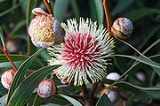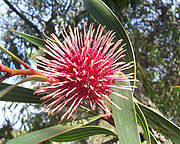
Hakea laurina
Encyclopedia
Hakea laurina is a plant of Southwest Australia
that is widely cultivated and admired. The species is often referred to as Kodjet, Pincushion Hakea, and Emu Bush. The specific epithet, derived from the Latin laurus, is given for the resemblance to the leaves of laurel
.
The habit of this plant is an upright shrub or tree, reaching a height between 2.5 and 6 metres. It does not possess a lignotuber
. The habitat is often sandplains, sometimes occurring on sandy-clay, most recorded specimens are in the southern districts of its botanical province.
Flowers are initially pale or cream, perhaps hidden by the leaves in the early stages, and are contained by scale-like bract
s before opening.
These are deep pink to red on the globular centre, a clustered flowerhead at the leaf axils, pale styles
emerge from these. This resembles a pin cushion. Nectar and a slight fragrance is produced from the flowerheads.
The flowering period occurs between April and August.
Leaves are simple and slightly blue green, they are flat, glabrous, have entire margins, and are obovate or lanceolate in outline, coming to a sharp point at the tip. The leaves vary in size on the plant, they may be 6– wide and reach 180 mm in length.
Foliage is dense and in alternate arrangement on the upright branchlets; in some forms this may be pendulous and reach the ground.
Bark is grey and smooth. Fruit is retained on the plant, is ovoid, slightly beaked at the end, and a smooth surface on the valve
.
The species occurs in the sandplains of the coastal Southwest of Australia, the northernmost range being Narrogin and extending east to Esperance
.
The plant, which is propagated from seeds, is used in cultivation in the Eastern states of Australia
, and as a hedging or street plant in America and Italy. Adaptable to a number of soil types, the plant is also tolerant of frost. The uses of this species include ornament and shading in public streets, wildlife habitat, windbreaks, and control of soil erosion.
In the language of flowers
, Hakea laurina symbolises nobility and longevity.

Southwest Australia
Southwest Australia is a biodiversity hotspot that includes the Mediterranean forests, woodlands, and scrub ecoregions of Western Australia. The region has a wet-winter, dry-summer Mediterranean climate, one of five such regions in the world...
that is widely cultivated and admired. The species is often referred to as Kodjet, Pincushion Hakea, and Emu Bush. The specific epithet, derived from the Latin laurus, is given for the resemblance to the leaves of laurel
Lauraceae
The Lauraceae or Laurel family comprises a group of flowering plants included in the order Laurales. The family contains about 55 genera and over 3500, perhaps as many as 4000, species world-wide, mostly from warm or tropical regions, especially Southeast Asia and South America...
.
The habit of this plant is an upright shrub or tree, reaching a height between 2.5 and 6 metres. It does not possess a lignotuber
Lignotuber
A lignotuber is a starchy swelling of the root crown possessed by some plants as a protection against destruction of the plant stem by fire. The crown contains buds from which new stems may sprout, and a sufficient store of nutrients to support a period of growth in the absence of...
. The habitat is often sandplains, sometimes occurring on sandy-clay, most recorded specimens are in the southern districts of its botanical province.
Flowers are initially pale or cream, perhaps hidden by the leaves in the early stages, and are contained by scale-like bract
Bract
In botany, a bract is a modified or specialized leaf, especially one associated with a reproductive structure such as a flower, inflorescence axis, or cone scale. Bracts are often different from foliage leaves. They may be smaller, larger, or of a different color, shape, or texture...
s before opening.
These are deep pink to red on the globular centre, a clustered flowerhead at the leaf axils, pale styles
Gynoecium
Gynoecium is most commonly used as a collective term for all carpels in a flower. A carpel is the ovule and seed producing reproductive organ in flowering plants. Carpels are derived from ovule-bearing leaves which evolved to form a closed structure containing the ovules...
emerge from these. This resembles a pin cushion. Nectar and a slight fragrance is produced from the flowerheads.
The flowering period occurs between April and August.
Leaves are simple and slightly blue green, they are flat, glabrous, have entire margins, and are obovate or lanceolate in outline, coming to a sharp point at the tip. The leaves vary in size on the plant, they may be 6– wide and reach 180 mm in length.
Foliage is dense and in alternate arrangement on the upright branchlets; in some forms this may be pendulous and reach the ground.
Bark is grey and smooth. Fruit is retained on the plant, is ovoid, slightly beaked at the end, and a smooth surface on the valve
Valve
A valve is a device that regulates, directs or controls the flow of a fluid by opening, closing, or partially obstructing various passageways. Valves are technically pipe fittings, but are usually discussed as a separate category...
.
The species occurs in the sandplains of the coastal Southwest of Australia, the northernmost range being Narrogin and extending east to Esperance
Esperance, Western Australia
Esperance is a large town in the Goldfields-Esperance region of Western Australia, located on the Southern Ocean coastline approximately east-southeast of the state capital, Perth. The shire of Esperance is home to 9,536 people as of the 2006 census, its major industries are tourism, agriculture,...
.
The plant, which is propagated from seeds, is used in cultivation in the Eastern states of Australia
Eastern states of Australia
In Australia, the term eastern states refers to the states adjoining the east coast of Australia. These are the mainland states of New South Wales, Queensland and Victoria. The Australian Capital Territory and Jervis Bay Territory, while not states, are also included. The term usually includes the...
, and as a hedging or street plant in America and Italy. Adaptable to a number of soil types, the plant is also tolerant of frost. The uses of this species include ornament and shading in public streets, wildlife habitat, windbreaks, and control of soil erosion.
In the language of flowers
Language of flowers
The language of flowers, sometimes called floriography, was a Victorian-era means of communication in which various flowers and floral arrangements were used to send coded messages, allowing individuals to express feelings which otherwise could not be spoken...
, Hakea laurina symbolises nobility and longevity.


